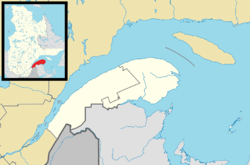Paspébiac
| Paspébiac | |
|---|---|
| City | |
 |
|
 Location within Bonaventure RCM. |
|
| Location in eastern Quebec. | |
| Coordinates: 48°02′N 65°15′W / 48.033°N 65.250°WCoordinates: 48°02′N 65°15′W / 48.033°N 65.250°W | |
| Country |
|
| Province |
|
| Region | Gaspésie– Îles-de-la-Madeleine |
| RCM | Bonaventure |
| Settled | 1755 |
| Constituted | August 20, 1997 |
| Government | |
| • Mayor | Paul-Arthur Blais |
| • Federal riding | Gaspésie— Îles-de-la-Madeleine |
| • Prov. riding | Bonaventure |
| Area | |
| • Total | 95.20 km2 (36.76 sq mi) |
| • Land | 94.54 km2 (36.50 sq mi) |
| Population (2011) | |
| • Total | 3,198 |
| • Density | 33.8/km2 (88/sq mi) |
| • Pop 2006-2011 |
|
| • Dwellings | 1,470 |
| Time zone | EST (UTC−5) |
| • Summer (DST) | EDT (UTC−4) |
| Postal code(s) | G0C 2K0 |
| Area code(s) | 418 and 581 |
| Highways |
|
| Website | www |
Paspébiac is a city on Baie des Chaleurs in the Gaspésie region of eastern Quebec, Canada. The population was 3,198 as of the Canada 2011 Census. The town is noted for the Banc de Pêche de Paspébiac, a large sandbar jutting out into the bay which has been designated a National Historic Site of Canada.
Paspébiac was Quebec's first cod fishing port. The town also has Basque roots and an accent which is different from the rest of the region. Its name may come from the Mi'kmaq espression papgeg ipsigiag, meaning "split flats" or "lagoon". Other sources indicate that the Mi'kmaq named it for Wospegiak' which means "shining in the distance."
In addition to Paspébiac itself, the town's territory also includes the communities of Duret, Paspébiac-Ouest, and Rivière-Paspébiac.
In 1707, the area was granted as a seignory to Pierre Haimard (1674–1724) and this marked the beginning of the colonization of Gaspésie's southern shores. But it only saw periodic visits during the fishing season until 1755 when settlers arrived from Acadia, Normandy, the Pays Basque, and, after the British conquest of Quebec, Jersey.
In 1767, the Jersey merchants Charles Robin and Company established there a permanent fishing operation and headquarters. This, together with its natural harbour, made Paspébiac the region's main commercial centre. The Robin and Le Boutillier installations on the barachois resembled a small town. Each company had a warehouse four or five storeys high, a general store, a wharf, a carpenter shop, a sail loft, a blacksmith shop and forge, a cooper shop for making barrels, offices, a cook-house, a boarding house for the apprentices, and numerous other buildings – besides the large area given over to the flakes and the drying fish. Set on the hill away from the fishery there were the Robin farm buildings and a large house, known as The Park, where the General Manager lived.
...
Wikipedia

